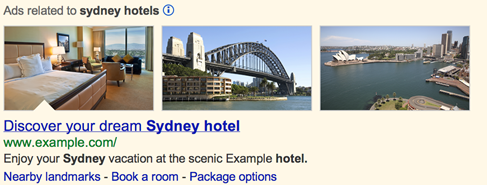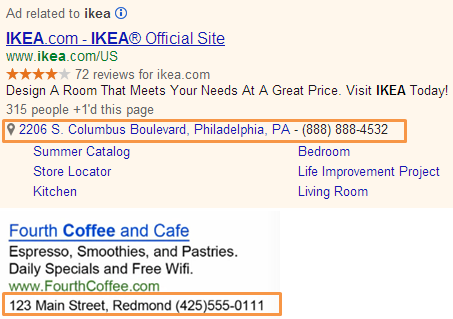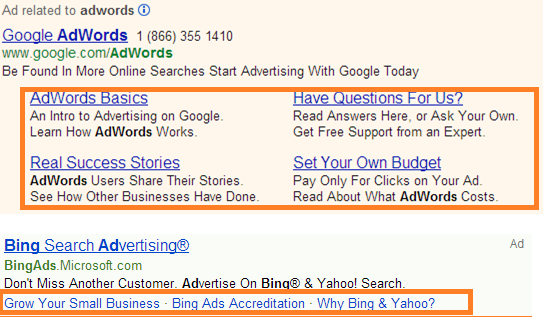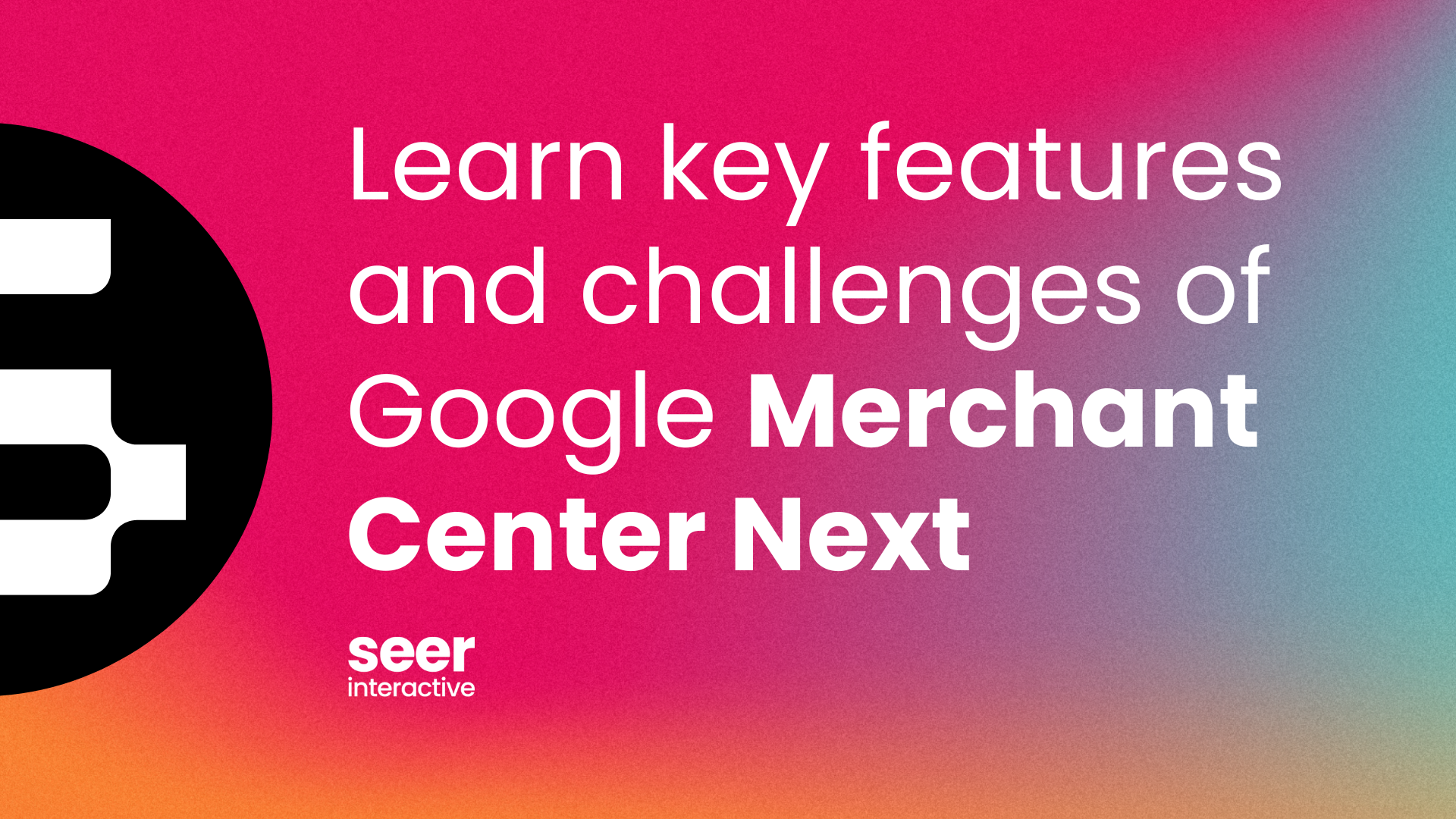Last week I provided an overview of ad extensions, how they work and their key benefits. Now let's take a deeper dive into the most popular types of ad extensions currently available, and when you might want to use each format.
Location Extensions
Most people think of SiteLinks when they think of ad extensions, but location extensions have actually been around the longest of all ad extensions!
Location extensions are available on both Google and Bing. They allow you to point users to a brick and mortar location in their area. Beyond that, Google reports that ads featuring location ad extensions enjoy a 10% higher CTR.
Location ads can be run on desktop devices and mobile as well, and can appear on their own or with other extensions.
Use location extensions if: you’d like to use paid search to drive offline sales and conversions.
Proceed with caution: if you don’t have a way of tracking online to offline conversions and aren't comfortable losing some traffic to physical locations.
SiteLink Extensions
As I described last week, SiteLinks are one of the most common types of ad extensions.
SiteLinks are also available on both Google and Bing. Until recently, Bing and Google SiteLinks looked and functioned in much the same way. SiteLinks offer the opportunity to add additional text links below your ad driving to different landing pages than the body of your ad.
Recently Google announced a big change in SiteLinks. Now in addition to the link text advertisers are able to add more detail beneath each SiteLink (as seen in the screenshot above) taking up even more SERP space and further boosting CTR. Another big change with Enhanced Campaigns is the ability to see performance data for individual Site Links, rather than just aggregated data at a campaign level.
Use SiteLinks if: you want more traffic! Really, SiteLinks are appropriate for almost all advertisers.
Proceed with caution: if you only have one landing page that converts well. While SiteLinks most often boost CTR in the main body of the ad, keep an eye on traffic that might be dead-ending when SiteLink clicks lead visitors to pages which don't convert well.
Call Extensions

Call extensions allow you to show a phone number with your ad. Unlike phone numbers which appear in location extensions, call extensions don’t need to be associated with one physical location. Call extensions are available on Google and available in limited release on Bing, and offer a few different options depending on your needs. Call extensions were heavily impacted by the migration to Enhanced Campaigns, so details may change as AdWords Enhanced Campaigns evolve!
Mobile or Desktop You can use call extensions on mobile devices or on desktop/laptops. On mobile devices call extensions are often referred to as “click-to-call.” You can specify that you would like your ads to be “call only” on mobile devices if you like, and clicks will be disabled. You will be charged for each call up to your maximum CPC bid.
Actual Number or Google Forwarding Number (Google only) With Enhanced Campaigns, you can elect to show your actual phone number or use a Google forwarding number. This means that Google will generate a number automatically for each ad group that will then reroute to your specified number.
Search or Display (Google only) Google upgraded call extensions are now available on the Google Display Network on high end mobile devices. Note that on the GDN your actual business number will show instead of a Google forwarding number.
Use call extensions if: you’re interested in phone calls as a type of conversion.
Proceed with caution: if your phone center is only open during certain hours. Make sure to use the campaign targeting settings so that your phone number is displayed only during relevant hours. Another consideration is the lack of visibility down to the keyword level in driving phone call conversions. If a significant percentage of your conversions are coming from call extensions you may want to break out high volume keywords into individual ad groups to accurately gauge keyword value. With enhanced campaigns, call extensions can now be set at the ad group level.
Offer Extensions

Offer extensions are available in limited release on Google. Like location extensions, offer extensions are a way to drive increased traffic to a brick and mortar location. Users can click on the offer extension to view a printable coupon that can be redeemed in-store. This is a great way to help gauge online to offline conversions.
Use offer extensions if: you’d like to drive more offline conversions.
Proceed with caution: if you’re seeing a lot of engagement without redemption. The cost of these clicks could add up, and if the users aren't making it to your physical location the expense may not make sense.
Social Extensions

Social extensions (also called social annotations) offer advertisers a way to show searchers how popular they are. If you have an active Google Plus account linked to your website and a significant amount of followers social extensions will be eligible to show.
Use social extensions if: you have a Google plus page.
Proceed with caution: if your pool of followers is especially small, or noticeably smaller than your competitors. You can opt out here.
Review Extensions/Seller Rating Extensions

Like social extensions, seller ratings extensions and review extensions both let you share a little bit about your reputation right in the body of your ad. Seller ratings extensions pull ratings automatically from Google Shopping once a domain has accumulated more than 30 unique reviews. Review extensions can be set by the advertiser.
Use review and seller rating extensions if: you are selling a good or service and have a great reputation.
Proceed with caution: if your rating is noticeably lower than your competitors. While seller ratings extensions show only for positive ratings (3.5 or higher), if you notice you are a lone 4 in a SERP of 5s you can opt out here.
Image Extensions

Image extensions launched about a month ago and are in beta on Google. While ecommerce advertisers have long had the option of including an image with their text ads via Product Listing Ads or the now-defunct Product Listing Extensions (see below) until now other advertisers had to rely on their ad copy to paint a picture. With image extensions all advertisers are given the option of including a visual component, so long as that component is not a logo or sneaky image ad. For more information on how to opt into image extensions fill out this form.
Ye Olde Extensions of Yore
If you've ever spotted a new or different ad format in the wild and reached out to Google about it you've probably heard some variation of this response: “Google is always testing new ad formats to deliver users the best experience possible.” Ad extensions seem to be one of Google’s favorite areas for testing, with new limited release extensions and betas regularly popping up and sometimes just as quickly disappearing. Here’s a quick closing list of some ad extensions I can think of from days gone by, feel free to comment with any other retired extensions you’d like to mourn or reminisce about!



